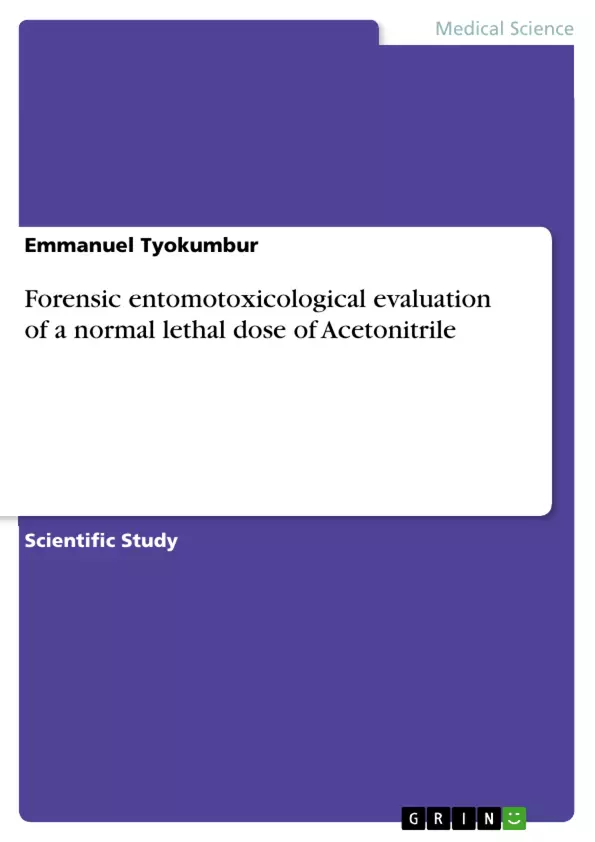A study was carried out on the forensic entomotoxicological evaluation of carrion insects of rabbits euthanized with Acetonitrile between February and March, 2023, at the stadium of the University of Ibadan. The rabbits were obtained from The Teaching and Research farm, University of Ibadan, Oyo state.
The rabbits were then euthanized with 10ml of Acetonitrile while the control group were scarified by cervical dislocation. Adult carrion insects were collected from the carrions using a sweep net and stored in 70% alcohol. The larvae were collected into a bowl by using a scoop, immobilized with hot water and later placed in sample bottles containing 70% alcohol. Pupae were also collected using forceps immobilized with hot water and later placed in sample bottles containing 70% alcohol. Ambient and carcass temperature was measured using infrared thermometer while relative humidity was recorded with a digital hygrometer.
Calliphoridae and Muscidae were the initial pioneers of the decomposing carcass and were seen during the fresh stage, while Sarcophagidae arrived shortly after the fresh stage of decomposition. It was found that Calliphoridae was the most dominant carrion insect while Sarcophagidae was the least dominant among the pioneer. The control group had more abundance and species composition of carrion insects than the paraquat-poisoned rabbits. The length and weight of the larvae as indices of growth were also observed to be comparatively higher in the control than the 10ml acetonitrile rabbit. The highest mean temperature value for the decomposing 10ml Acetonitrile-treated rabbits was 31.90°C while its lowest mean value was 22.60°C. The highest mean relative humidity value was 99% while the least recorded was 42% due to the rainy season.
Acetonitrile was found to retard the growth of carrion larva as shown in Musca domestica when compared with the control. Overall, rapid decomposition rate was recorded due to high ambient and carcass temperatures in the tropics. It can be deduced from this study that carrion insects are essential in providing the essential ecosystem service of decomposition and can be used in solving suicide puzzles through the extrication of post mortem intervals in conjunction with environmental variables. More studies are therefore needed to test the specific effects of other commonly used suicide poisons on carrion insects in Nigeria.
Inhaltsverzeichnis (Table of Contents)
- CHAPTER ONE INTRODUCTION.
- 1.1 Entomotoxicology....
- 1.2 Carrion insects
- 1.3 Acetonitrile
- 1.4 Justification for the study..\n
- 1.5 Aims and objectives of the study.
- CHAPTER TWO LITERATURE REVIEW.
- 2.1 Introduction........
- 2.2 Decomposition .......
- 2.3 Insect succession..\n
- 2.4 Factors affecting insect succession.
- 2.5 Types of carrion insects and Arthropods.
- 2.6 Acetonitrile
- 2.7 Review of previous literatures in Nigeria.
- CHAPTER THREE MATERIALS AND METHOD.
- 3.1 Study site...\n
- 3.2 Measurement of larval body length and weight..\n
- 3.3 Measurement of carcass temperature and humidity.
- CHAPTER FOUR RESULTS
- 4.1 Abundance and species composition of carrion insects on rabbit carcass .\n
- 4.2 Carrion insect succession on rabbit carcass
- 4.3 Effects of Acetonitrile on the length and weight of the control and 10ml larva.\n
- 4.4 Variations in environmental variables at the field site
- CHAPTER FIVE DISCUSSION.
- 5.1 Abundance and specie composition of carrion insects on rabbit carcass..\n
- 5.2 Carrion insect succession on rabbit carcass
- 5.3 Effects of Acetonitrile on the length and weight of larva ......\n
- 5.4 Variations in environmental variables at the field site.\n
- 5.5 CONCLUSION..\n
- REFERENCES
Zielsetzung und Themenschwerpunkte (Objectives and Key Themes)
This research aims to investigate the entomotoxicological effects of acetonitrile on carrion insects, specifically focusing on the normal lethal dose of acetonitrile in the context of forensic entomology. The study utilizes a rabbit carcass as a model system to observe the impact of acetonitrile on carrion insect development and population dynamics.- Forensic entomology and its application in determining time of death.
- The role of carrion insects in decomposition and their ecological significance.
- The toxicological effects of acetonitrile on carrion insect populations.
- The influence of environmental factors on insect succession and decomposition processes.
- The application of this research to forensic investigations and the estimation of post-mortem intervals.
Zusammenfassung der Kapitel (Chapter Summaries)
- Chapter One: Introduction - This chapter sets the context for the study by defining key concepts like entomotoxicology, carrion insects, and acetonitrile. It outlines the justification for the study and its specific aims and objectives.
- Chapter Two: Literature Review - This chapter provides a comprehensive overview of existing research on decomposition, insect succession, factors affecting insect succession, carrion insect types, acetonitrile, and previous studies conducted in Nigeria related to the topic.
- Chapter Three: Materials and Methods - This chapter details the methodology used in the study, including the study site, the methods of measuring larval body length and weight, and the procedures for recording carcass temperature and humidity.
- Chapter Four: Results - This chapter presents the findings of the study, including the abundance and species composition of carrion insects collected from the rabbit carcass, the carrion insect succession on the rabbit carcass, the effects of acetonitrile on the length and weight of larvae, and variations in environmental variables at the field site.
- Chapter Five: Discussion - This chapter analyzes and interprets the findings of the study, discussing the observed abundance and species composition, the insect succession patterns, the effects of acetonitrile on larvae, the role of environmental variables, and the potential applications of the research to forensic investigations.
Schlüsselwörter (Keywords)
The primary focus of this research is on the entomotoxicological evaluation of acetonitrile on carrion insects, utilizing a rabbit carcass as a model system for studying the normal lethal dose. This research utilizes forensic entomology principles and focuses on the ecological impact of acetonitrile on carrion insect succession and development, as well as the potential implications of these findings for forensic investigations and determining time of death.- Quote paper
- Emmanuel Tyokumbur (Author), 2023, Forensic entomotoxicological evaluation of a normal lethal dose of Acetonitrile, Munich, GRIN Verlag, https://www.hausarbeiten.de/document/1394612


